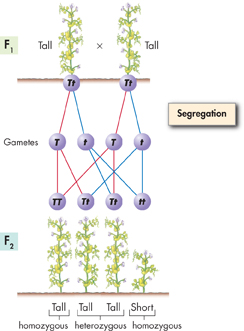Explaining the F1 Cross To begin with, Mendel assumed that a dominant allele had masked the corresponding recessive allele in the F1 generation. However, the trait controlled by the recessive allele did show up in some of the F2 plants. This reappearance indicated that, at some point, the allele for shortness had separated from the allele for tallness. How did this separation, or segregation, of alleles occur? Mendel suggested that the alleles for tallness and shortness in the F1 plants must have segregated from each other during the formation of the sex cells, or gametes (GAM eetz). Did that suggestion make sense?
The Formation of Gametes Let's assume, as Mendel might have, that all the F1 plants inherited an allele for tallness from the tall parent and one for shortness from the short parent. Because the allele for tallness is dominant, all the F1 plants are tall.  During gamete formation, the alleles for each gene segregate from each other, so that each gamete carries only one allele for each gene. Thus, each F1 plant produces two kinds of gametes—those with the tall allele and those with the short allele.
During gamete formation, the alleles for each gene segregate from each other, so that each gamete carries only one allele for each gene. Thus, each F1 plant produces two kinds of gametes—those with the tall allele and those with the short allele.
Look at Figure 11–5 to see how alleles separate during gamete formation and then pair up again in the F2 generation. A capital letter represents a dominant allele. A lowercase letter represents a recessive allele. Now we can see why the recessive trait for height, t, reappeared in Mendel's F2 generation. Each F1 plant in Mendel's cross produced two kinds of gametes—those with the allele for tallness and those with the allele for shortness. Whenever a gamete that carried the t allele paired with the other gamete that carried the t allele to produce an F2 plant, that plant was short. Every time one or both gametes of the pairing carried the T allele, a tall plant was produced. In other words, the F2 generation had new combinations of alleles.

FIGURE 11–5 Segregation During gamete formation, alleles segregate from each other so that each gamete carries only a single copy of each gene. Each F1 plant makes two types of gametes—those with the allele for tallness and those with the allele for shortness. The alleles are paired up again when gametes fuse during fertilization.
d11.1 Assessment

-
Review What did Mendel conclude determines biological inheritance?
Explain What are dominant and recessive alleles?
Apply Concepts Why were true-breeding pea plants important for Mendel's experiments?
-
Review What is segregation?
Explain What happens to alleles between the P generation and the F2 generation?
Infer What evidence did Mendel use to explain how segregation occurs?
VISUAL THINKING
Use a diagram to explain Mendel's principles of dominance and segregation. Your diagram should show how alleles segregate during gamete formation.

Table of Contents
- Formulas and Equations
- Applying Formulas and Equations
- Mean, Median, and Mode
- Estimation
- Using Measurements in Calculations
- Effects of Measurement Errors
- Accuracy
- Precision
- Comparing Accuracy and Precision
- Significant Figures
- Calculating With Significant Figures
- Scientific Notation
- Calculating With Scientific Notation
- Dimensional Analysis
- Applying Dimensional Analysis




